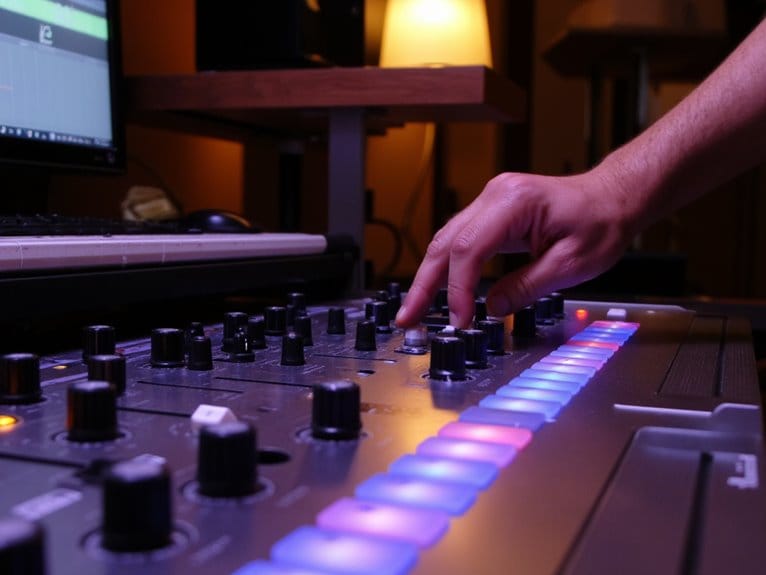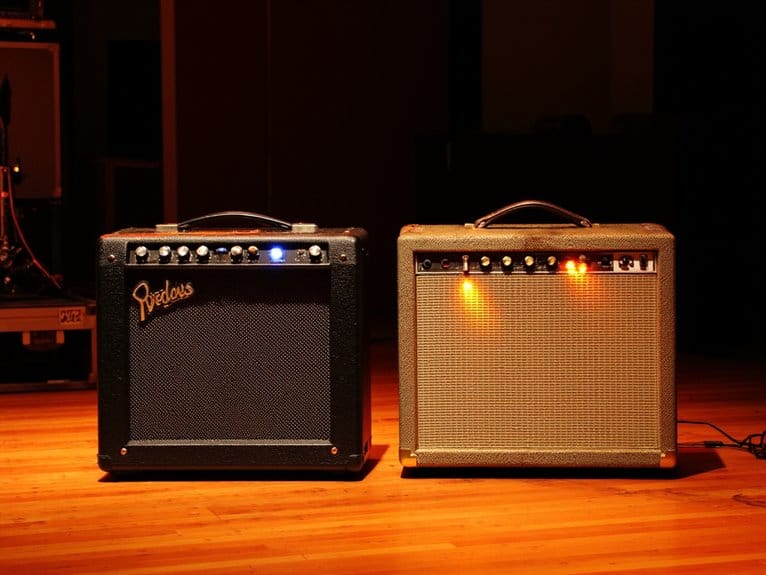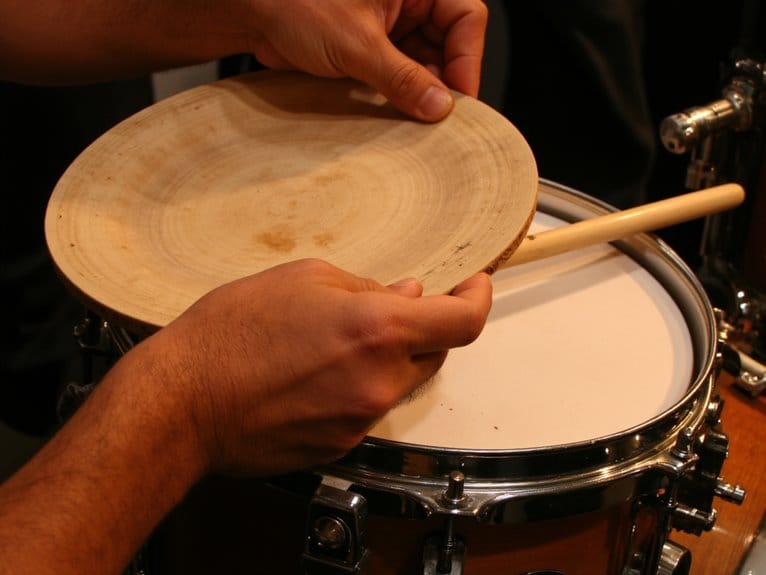Polyrhythmic Concepts for Drummers
You’ll master polyrhythmic concepts by understanding how conflicting pulse patterns create sophisticated musical tension through layered, incongruous steady beats. Start with basic 3:2 polyrhythms, practicing hi-hat triplets against snare eighth notes at slower tempos to build limb independence and neural foundations. Incorporate ghost notes, accent displacement, and unconventional sticking techniques while exploring cultural applications from African traditions to progressive metal. These systematic practice routines will reveal advanced coordination techniques that await your exploration.
We are supported by our audience. When you purchase through links on our site, we may earn an affiliate commission, at no extra cost for you. Learn more.
Notable Insights
- Polyrhythms involve playing simultaneous conflicting pulse patterns, like three notes against two notes, creating structured rhythmic tension.
- Start with 3:2 polyrhythms using hi-hat triplets against snare eighth notes, practicing slowly to understand timing relationships.
- Develop limb independence through systematic practice of single-stroke patterns and paradiddle exercises with varying bass drum combinations.
- Incorporate ghost notes, accent displacement, and rim clicks to add rhythmic textures and dynamic interplay to polyrhythmic patterns.
- Study traditional African drumming, Afro-Cuban music, and jazz pioneers like Elvin Jones for authentic polyrhythmic applications and cultural context.
Fundamental Concepts and Definitions of Polyrhythms
The heartbeat of polyrhythm lies in its fundamental challenge to our natural inclination toward rhythmic conformity, as it demands that we simultaneously embrace two or more conflicting pulse patterns that refuse to align in predictable ways.
Understanding polyrhythm basics requires you to think beyond simple time signatures, where instead of playing rhythms that nest comfortably together like eighth notes within quarter notes, you’re layering incongruous steady pulses that create deliberate rhythmic tension.
The classic 3:2 polyrhythm exemplifies this concept perfectly, cycling three notes against two notes within identical time frames, forcing your brain to process multiple pulse layers simultaneously.
This isn’t merely complex variation but structured overlapping patterns that repeat cyclically, creating the foundation for genres ranging from African traditions to progressive metal.
Essential Exercises and Application Techniques
Once you’ve grasped the theoretical foundation of polyrhythms, I’ve found that translating this knowledge into physical coordination requires a methodical approach that builds muscle memory through deliberate, progressive exercises.
Start with the fundamental 3/2 polyrhythm-hi-hat triplets against snare eighth notes-as your cornerstone pattern. These essential warm ups should begin at slower tempos, allowing you to dissect timing relationships before increasing speed.
Master the 3/2 polyrhythm foundation by practicing hi-hat triplets against snare eighth notes at deliberate, slower tempos first.
I recommend practicing each limb’s pattern separately until it becomes automatic, then gradually combining them. Move the triplet pattern to your bass drum while maintaining snare eighth notes, challenging your limb independence further.
Layer polyrhythms into existing grooves by adding subtle accents or ghost notes, which enhances your rhythmic creativity and transforms mechanical exercises into musical expressions with practical applications.
Advanced Coordination and Hand Techniques
While fundamental polyrhythmic patterns establish the groundwork, developing sophisticated hand techniques transforms these mechanical exercises into expressive musical statements that’ll elevate your playing beyond basic coordination drills.
Ghost notes become your secret weapon for adding rhythmic textures beneath primary accents, while accent displacement creates shifting emphases that generate dynamic interplay with your foot work.
I’ve found that substituting traditional sticking techniques with unconventional approaches-like reversing hand patterns against steady foot ostinatos-dramatically improves independence.
Incorporating rim clicks and cross-stick variations into your hand patterns introduces essential tonal variations without sacrificing rhythmic precision.
These coordination drills, though challenging initially, develop the micro-timing control necessary for clean polyrhythmic execution across complex time signatures.
Developing Limb Independence and Symmetrical Awareness
Building effective limb independence requires a systematic approach that’ll challenge your brain’s natural tendency to mirror movements across your body, and I’ve discovered that starting with simple single-stroke patterns creates the neural foundation necessary for complex polyrhythmic execution.
Your limb coordination develops through consistent eighth-note snare patterns while gradually introducing bass drum and hi-hat variations, which forces cognitive separation between appendages.
I’ve found paradiddle exercises particularly effective for developing this rhythmic focus, especially when you transfer the LRLL pattern between hands and feet.
The real breakthrough comes when you can maintain steady hand patterns while improvising footwork, though honestly, left-foot independence remains challenging even for experienced players. Just as double-braced construction provides enhanced stability for drum hardware, establishing a solid foundational practice routine creates the structural support necessary for advanced polyrhythmic techniques. Visualization exercises in the mind before attempting them physically helps establish proper movement patterns without rushing into complex coordination challenges. This approach transforms what could be mechanical repetition into meaningful artistic expression that connects independent movements into unified rhythm.
Daily ten-minute sessions targeting these fundamentals will accelerate your multi-limb control substantially.
Musical Styles and Cultural Applications
Now that you’ve built the technical foundation for polyrhythmic drumming through limb independence exercises, understanding how these concepts apply across different musical cultures and genres will expand your rhythmic vocabulary exponentially.
I’ve found that studying traditional African polyrhythms provides the most authentic starting point for this exploration. The cultural significance of West African drumming ensembles reveals how layered meters create communal timing, while Afro-Cuban music demonstrates 3-over-2 patterns in compositions like Mongo Santamaria’s “Afro Blue.”
This rhythmic evolution flows naturally into jazz, where drummers like Elvin Jones popularized 4-against-3 patterns, then progresses through progressive rock bands like King Crimson and into contemporary classical applications. Each genre adapts polyrhythmic concepts to serve their unique musical needs.
When recording these complex polyrhythmic patterns, professional drummers often rely on low latency audio interfaces to ensure precise timing between live performance and digital monitoring, as even slight delays can disrupt the intricate timing relationships essential to polyrhythmic execution.
On a final note
You’ve now got the foundational tools to tackle polyrhythmic drumming, though I’ll admit the journey from here requires serious dedication. Start with simple 2-against-3 patterns, gradually building your limb independence through consistent practice. Don’t rush into complex African or Latin applications until you’ve mastered basic coordination-trust me, I’ve seen too many drummers stumble by skipping fundamentals. Your musical vocabulary will expand dramatically once these concepts become second nature.






